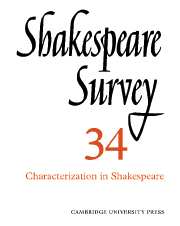Book contents
- Frontmatter
- Shakespeare’s Open Secret
- The Emergence of Character Criticism, 1774–1800
- Society and the Individual in Shakespeare’s Conception of Character
- Realistic Convention and Conventional Realism in Shakespeare
- On Expectation and Surprise: Shakespeare’s Construction of Character
- Shakespeare and the Ventriloquists
- The Rhetoric of Character Construction: Othello
- Characterizing Coriolanus
- The Ironic Reading of The Rape of Lucrece and the Problem of External Evidence
- The Unity of Romeo and Juliet
- No Abuse: The Prince and Falstaff in the Tavern Scenes of Henry IV
- Twelfth Night: The Experience of the Audience
- Plays and Playing in Twelfth Night
- Sceptical Visions: Shakespeare’s Tragedies and Jonson’s Comedies
- Shakespeare in Performance, 1980
- The Year's Contributions to Shakespearian Study 1 Critical Studies
- 2 Shakespeare’s Life, Times and Stage
- 3 Textual Studies
- Index
- Plate Section
3 - Textual Studies
Published online by Cambridge University Press: 28 March 2007
- Frontmatter
- Shakespeare’s Open Secret
- The Emergence of Character Criticism, 1774–1800
- Society and the Individual in Shakespeare’s Conception of Character
- Realistic Convention and Conventional Realism in Shakespeare
- On Expectation and Surprise: Shakespeare’s Construction of Character
- Shakespeare and the Ventriloquists
- The Rhetoric of Character Construction: Othello
- Characterizing Coriolanus
- The Ironic Reading of The Rape of Lucrece and the Problem of External Evidence
- The Unity of Romeo and Juliet
- No Abuse: The Prince and Falstaff in the Tavern Scenes of Henry IV
- Twelfth Night: The Experience of the Audience
- Plays and Playing in Twelfth Night
- Sceptical Visions: Shakespeare’s Tragedies and Jonson’s Comedies
- Shakespeare in Performance, 1980
- The Year's Contributions to Shakespearian Study 1 Critical Studies
- 2 Shakespeare’s Life, Times and Stage
- 3 Textual Studies
- Index
- Plate Section
Summary
The Arden Shakespeare has graced the year with the publication of two volumes, A Midsummer Night’s Dream and Romeo and Juliet, so happily paired that we are tempted to suppose that the General Editors, joined now by Brian Morris, planned it that way from the beginning. It is not so, of course, for Brian Gibbons, the successor to the late John Crow in the editorship of Romeo and Juliet, began his work ‘from scratch in 1973’; and Harold F. Brooks confesses in his preface that ‘ A Midsummer Night’s Dream has had a pre-eminent place’ in his affections since the afternoon in 1914 when he attended Granville-Barker’s golden production. It is not too much to say that Brooks’s edition, bearing yet the marks of that inspiration, began at that matinée.
The conjunction of the two volumes sharpens our perspective on the relationships between the two plays. The most interesting of these to this reviewer is the question of dating. Brooks assembles all possible material on the date of A Midsummer Night's Dream from literary, topical, occasional, and stylistic considerations (twenty-three pages) and concludes that it 'was composed in the winter of 1595-6, for the Carey wedding' on 19 February 1596 (p. lvii) and that it probably followed Romeo and Juliet (p. xliii).
- Type
- Chapter
- Information
- Shakespeare Survey , pp. 187 - 198Publisher: Cambridge University PressPrint publication year: 1982

